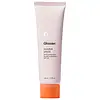What's inside
What's inside
 Key Ingredients
Key Ingredients

 Benefits
Benefits

 Concerns
Concerns

 Ingredients Side-by-side
Ingredients Side-by-side

Butyl Methoxydibenzoylmethane 3%
UV AbsorberHomosalate 6%
Skin ConditioningEthylhexyl Salicylate 5%
UV AbsorberWater
Skin ConditioningButyloctyl Salicylate
Skin ConditioningDipropylene Glycol
HumectantMethyl Trimethicone
Skin ConditioningBiosaccharide Gum-4
Skin ConditioningCaprylyl Methicone
Skin ConditioningPropanediol
SolventBis-Ethylhexyl Hydroxydimethoxy Benzylmalonate
AntioxidantBetaine
HumectantAcrylates Copolymer
Ammonium Acryloyldimethyltaurate/Vp Copolymer
Hydroxyacetophenone
AntioxidantPhenoxyethanol
PreservativeHydrolyzed Wheat Protein/Pvp Crosspolymer
Dibutyl Lauroyl Glutamide
Skin ConditioningDibutyl Ethylhexanoyl Glutamide
Skin ConditioningButylene Glycol
HumectantCitrus Aurantium Dulcis Peel Oil
MaskingDipotassium Glycyrrhizate
HumectantCarbomer
Emulsion StabilisingTocopheryl Acetate
AntioxidantAminomethyl Propanol
BufferingHippophae Rhamnoides Fruit Extract
Skin ConditioningDisodium EDTA
Pentylene Glycol
Skin ConditioningAloe Barbadensis Leaf Extract
EmollientSilica
AbrasiveBioflavonoids
Skin ConditioningPotassium Sorbate
PreservativeHydroxyphenyl Propamidobenzoic Acid
Skin ConditioningBrassica Oleracea Italica Extract
AstringentEthylhexylglycerin
Skin ConditioningCamellia Sinensis Leaf Extract
AntimicrobialAscorbyl Palmitate
AntioxidantButyl Methoxydibenzoylmethane 3%, Homosalate 6%, Ethylhexyl Salicylate 5%, Water, Butyloctyl Salicylate, Dipropylene Glycol, Methyl Trimethicone, Biosaccharide Gum-4, Caprylyl Methicone, Propanediol, Bis-Ethylhexyl Hydroxydimethoxy Benzylmalonate, Betaine, Acrylates Copolymer, Ammonium Acryloyldimethyltaurate/Vp Copolymer, Hydroxyacetophenone, Phenoxyethanol, Hydrolyzed Wheat Protein/Pvp Crosspolymer, Dibutyl Lauroyl Glutamide, Dibutyl Ethylhexanoyl Glutamide, Butylene Glycol, Citrus Aurantium Dulcis Peel Oil, Dipotassium Glycyrrhizate, Carbomer, Tocopheryl Acetate, Aminomethyl Propanol, Hippophae Rhamnoides Fruit Extract, Disodium EDTA, Pentylene Glycol, Aloe Barbadensis Leaf Extract, Silica, Bioflavonoids, Potassium Sorbate, Hydroxyphenyl Propamidobenzoic Acid, Brassica Oleracea Italica Extract, Ethylhexylglycerin, Camellia Sinensis Leaf Extract, Ascorbyl Palmitate
Butyl Methoxydibenzoylmethane 3%
UV AbsorberHomosalate 7%
Skin ConditioningEthylhexyl Salicylate 5%
UV AbsorberOctocrylene 10%
UV AbsorberIsododecane
EmollientDimethicone/Bis-Isobutyl PPG-20 Crosspolymer
EmollientCaprylic/Capric Triglyceride
MaskingButyloctyl Salicylate
Skin ConditioningPolysilicone-22
Dimethicone Crosspolymer
Emulsion StabilisingDicaprylyl Ether
EmollientGlycine Soja Oil
EmollientCarthamus Tinctorius Seed Oil
MaskingPolyglyceryl-3 Diisostearate
EmulsifyingOryza Sativa Germ Extract
EmollientOryza Sativa Extract
AbsorbentAloe Barbadensis Leaf Juice
Skin ConditioningBisabolol
MaskingTocopherol
AntioxidantZingiber Officinale Root Extract
MaskingButyl Methoxydibenzoylmethane 3%, Homosalate 7%, Ethylhexyl Salicylate 5%, Octocrylene 10%, Isododecane, Dimethicone/Bis-Isobutyl PPG-20 Crosspolymer, Caprylic/Capric Triglyceride, Butyloctyl Salicylate, Polysilicone-22, Dimethicone Crosspolymer, Dicaprylyl Ether, Glycine Soja Oil, Carthamus Tinctorius Seed Oil, Polyglyceryl-3 Diisostearate, Oryza Sativa Germ Extract, Oryza Sativa Extract, Aloe Barbadensis Leaf Juice, Bisabolol, Tocopherol, Zingiber Officinale Root Extract
 Reviews
Reviews

Ingredients Explained
These ingredients are found in both products.
Ingredients higher up in an ingredient list are typically present in a larger amount.
Also known as Avobenzone, this ingredient is a chemical sunscreen filter that provides protection in the UV-A range.
Avobenzone is globally approved and is the most commonly used UV-A filter in the world.
Studies have found that avobenzone becomes ineffective when exposed to UV light (it is not photostable; meaning that it breaks down in sunlight). Because of this, formulations that include avobenzone will usually contain stabilizers such as octocrylene.
However, some modern formulations (looking at you, EU!) are able to stabilize avobenzone by coating the molecules.
Avobenzone does not protect against the UV-B range, so it's important to check that the sunscreen you're using contains other UV filters that do!
The highest concentration of avobenzone permitted is 3% in the US, and 5% in the EU.
Learn more about Butyl MethoxydibenzoylmethaneButyloctyl Salicylate is a chemical UV filter structurally similar to octisalate. It is a photostabilizer, SPF booster, emollient and solvent. This ingredient helps evenly spread out ingredients.
According to a manufacturer, it is suitable for pairing with micro Titanium Dioxide, Zinc Oxide, and pigments.
Photostabilizers help stabilize UV-filters and prevents them from degrading quickly.
Learn more about Butyloctyl SalicylateEthylhexyl Salicylate is an organic compound used to block UV rays. It primarily absorbs UVB rays but offers a small amount of UVA protection as well.
Commonly found in sunscreens, Ethylhexyl Salicylate is created from salicylic acid and 2-ethylhexanol. You might know salicylic acid as the effective acne fighter ingredient and BHA.
The ethylhexanol in this ingredient is a fatty alcohol and helps hydrate your skin, similar to oils. It is an emollient, which means it traps moisture into the skin.
According to manufacturers, Ethylhexyl Salicylate absorbs UV wavelength of 295-315 nm, with a peak absorption at 307-310 nm. UVA rays are linked to long term skin damage, such as hyperpigmentation. UVB rays emit more energy and are capable of damaging our DNA. UVB rays cause sunburn.
Learn more about Ethylhexyl SalicylateHomosalate is a chemical sunscreen filter that provides protection in the UV-B range (280nm - 320 nm), with a peak protection at 306 nm. It is internationally approved for use in sunscreens.
Homosalate is not photo-stable, meaning it's strength as a UV filter degrades over time with exposure to the sun. Because of this, it's often used in combination with other chemical sunscreen filters as avobenzone (which protects from the UV-A range). Homosalate also helps act as a solvent for harder-to-dissolve UV filters.
(Part of the reason that sunscreens need to be frequently re-applied is due to the photo instability of many chemical sunscreen filters)
Currently, homosalate is approved in concentrations up to 10% in the EU and 15% in the US. The FDA is currently doing further research on the effects of homosalate, and it is possible that these approved concentrations will change in the future.
Learn more about Homosalate